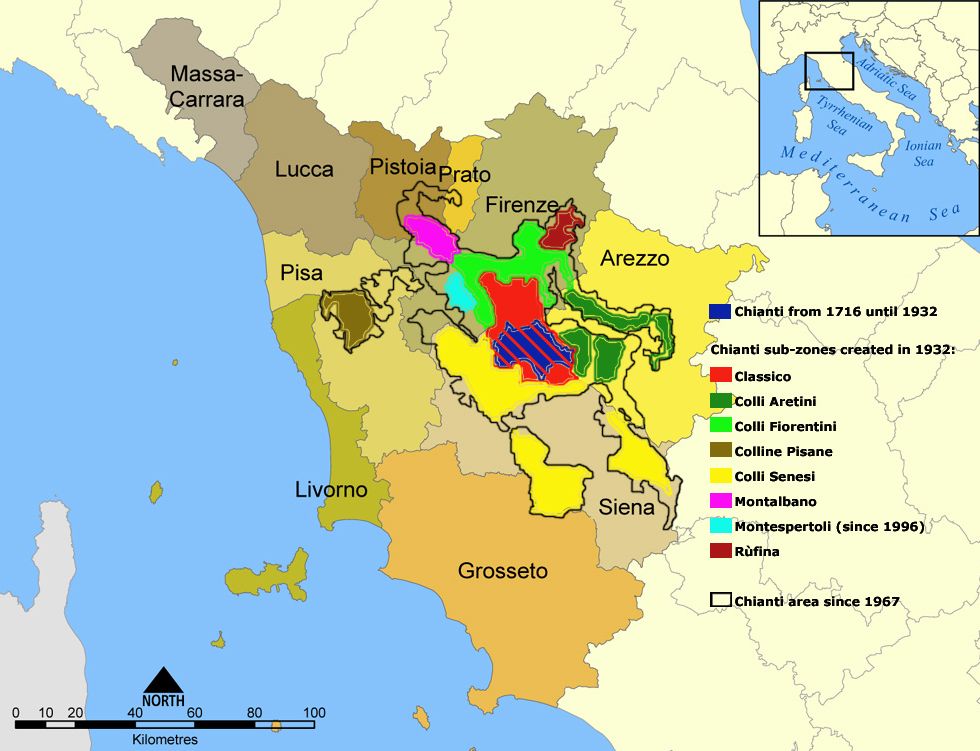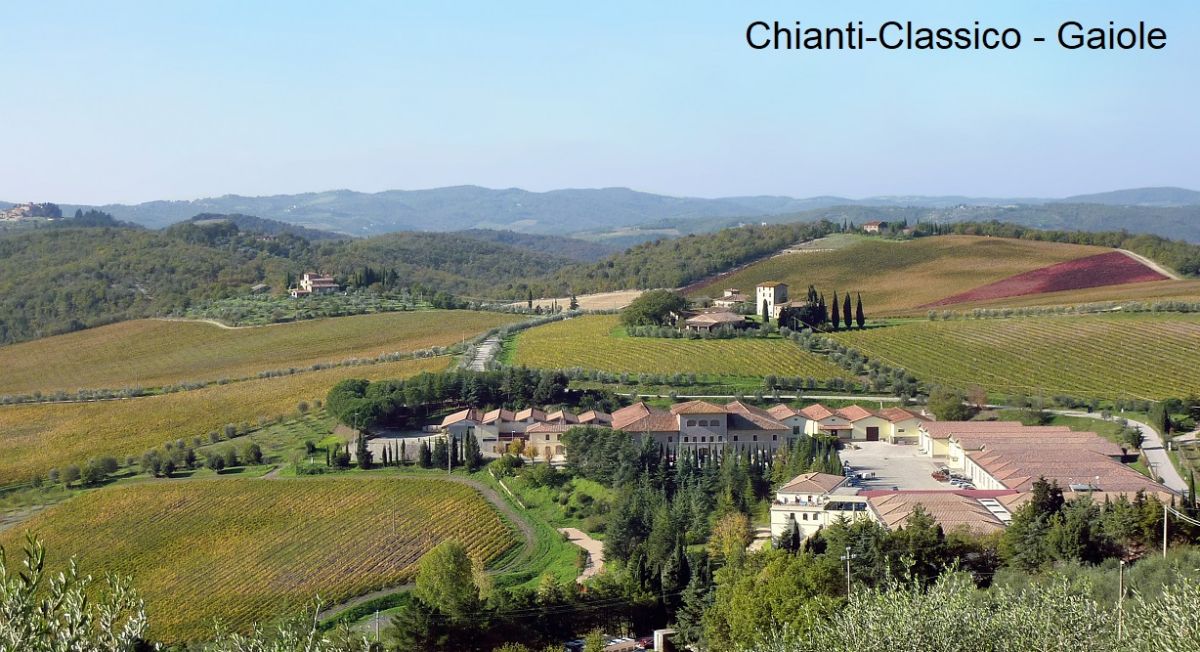Results
2,284 Results
Loading more Results ...
Loading more Results ...
| Chianti Classico DOCG |
Description to Chianti Classico DOCG
DOCG area for red wine in the Italian region of Tuscany. This wine, which is one level higher than "normal" Chianti, comes from the classic zone defined back in 1716 by Grand Duke Cosimo III (1642-1723) of the Medici family, although it was much smaller at the time. In 1932, further areas and municipalities were added to complete the current area. The densely wooded area covers 70,000 hectares, but only 7,000 hectares are used for viticulture. The suburbs of Florence form the border to the north, the Chianti mountains to the east, the Pesa and Elsa rivers to the west and Siena to the south. The "Via Chiantigiana" wine route, which is around 70 kilometres long, connects the two cities of Florence and Siena. The area includes the municipalities of Castellina, Gaiole, Greve and Radda in their entirety, as well as the municipalities of Barberino Val d'Elsa, Castelnuovo Berardenga, Poggibonsi, San Casciano and Tavarnelle Val di Pesa in part. There is also a separate DOC area for the sweet wine Vin Santo del Chianti Classico.

The trademark of the Chianti Classico area and also of the "Consorzio del Marchio Storico Chianti Classico" is Gallo nero (black cockerel), which goes back to the legend described in Chianti about the creation of the borders.
Soil types
The best sites are the middle altitudes south of Greve, north of Radda and Castellina and the slopes stretching from Gaiole southwards to Castelnuovo in the direction of the Arbia Valley. In contrast to the normal Chianti area, there are numerous hilly areas between 250 and 600 metres above sea level with dry and warm soils. The typical Chianti Classico soil types are Galestro (loose limestone marl) and Alberese (weathered sandstone), which do not become too moist even during heavy rainfall. Galestro also gave its name to an IGT white wine.

Demarcation from the Chianti region
In the past, Chianti-Classico had more and more problems distinguishing itself from its "younger brother" Chianti; the two wines were often confused due to the similarity of their names. The Consorzio has therefore issued a number of standards to emphasise the qualitative difference. The basic statement is that these are two categories of wine that are fundamentally different in terms of production methods, qualitative characteristics and environmental conditions, despite certain similarities. The two wines can therefore be regarded as independent, even if for historical reasons they merge into the single protected designation of origin Chianti.

New regulations from 2006
The new regulations came into force in 2006 after a transitional period of several years. Normal Chianti may no longer be produced in the Chianti Classico region. If the yield limits or the minimum alcohol content are not met, the (previously existing) possibility of declassification to normal Chianti is no longer permitted. Bottling must be carried out within the production area, which is not required by Italian wine law for any other wine. The wine may be marketed no earlier than 1 October of the year following the harvest.
The minimum proportion of Sangiovese has been increased from 75% to 80%, although single-varietal wines are also permitted. The proportion of other red varieties may not exceed 20%. This is mostly Canaiolo Nero, as well as Cabernet Sauvignon, Merlot and Syrah. The previously authorised white varieties Malvasia del Chianti (Malvasia Bianca Lunga) and Trebbiano Toscano are now prohibited. The maximum permitted yield applies both per plant with a maximum of three kilograms per vine and per hectare with 7,500 kilograms (which corresponds to a total quantity of 52.5 hectolitres of wine); the maximum must yield is 70%. The alcohol content must be at least 12% vol. and the residual sugar must not exceed 4 g/litre. With 12.5% vol. and a maturation period of 24 months (of which at least three months in the bottle), it can be called Riserva. Riservas are only produced by the best producers in very good years. The best vintages are 1985, 1988, 1990, 1993, 1995, 1997, 1999, 2001 and 2004.
Three-tier quality pyramid from 2014
A new three-tier quality pyramid was introduced at the beginning of 2014. "Chianti Classico Annata" forms the basis. The middle level "Chianti Classico Riserva" corresponds to the "old" specifications. New is the top quality "Chianti Classico Gran Selezione" with a maturation period of at least 30 months (of which at least three months in bottle), whereby the grapes must come exclusively from the producer. There are even stricter regulations than for the Riserva, these are deep ruby red colour, spicy persistent aroma, dry balanced taste, at least 13% alcohol by volume, at least 4.5 g/l total acidity and at least 26 g/l extract. Furthermore, this wine may not be bottled in the folkloristic bast bottle Fiasco. Wines from the 2010 vintage that have not yet been marketed can be retroactively declared with the new quality class.
Indication of the subzones from 2023
The "Chianti-Classico Consortium" has adopted new regulations to further emphasise the idea of origin. From 1 July 2023, Chianti Classico producers will be allowed to indicate the eleven additional geographical indications UGA (Unità Geografica Aggiuntiva) introduced in 2021 on the label of the top category "Gran Selezione" introduced in 2014. The subzones are Castellina, Castelnuovo Berardenga, Gaiole, Greve, Lamole, Montefioralle, Panzano, Radda, San Casciano, San Donato in Poggio (including Barberino Tavarnelle and Poggibonsi) and Vagliagli. There are also plans to introduce the subzones for the Annata (vintage) and Riserva wine types in a second step. The proportion of Sangiovese is to be increased from the current 80 to 90% and international varieties will no longer be permitted. For the remaining 10%, only other indigenous red wine varieties from Tuscany may be used.
Producers
The best-known producers in the Chianti Classico area include Antinori, Antica Fattoria dei S. Andrea di Niccolò Machiavelli, Badia a Coltibuono, Bianchi Bandinelli, La Brancaia, Cantine Leonardo da Vinci, Carobbio, Casa Emma, Castellani Spa, Castello Banfi, Castello dei Rampolla, Castello del Trebbio, Castello di Ama, Castello di Brolio (Ricasoli), Castello di Fonterutoli, Castello di Lucignano, Castello di Monsanto, Castello di Monterinaldi, Castello di Querceto, Castello di Verrazzano, Castello di Vicchiomaggio, Cennatoio, Collolungo, Dievole, Donatella Cinelli Colombini, Fattoria Casaloste, Fattoria di Cinciano, Fattoria di Fèlsina, Fattoria Le Fonti, Fattoria Viticcio, Fontodi, Frescobaldi, Guicciardini, Il Mandorlo, Isole e Olena, Istine, La Massa, Le Filigare, Mangiacane, Mannucci Droandi, Melini, Monte Vertine, Nittardi, Ormanni, Paneretta, Panzanello, Poci, Podere Casanova, Podere Il Palazzino, Podere Perseto, Quercia al Poggio, Querciabella, Ricasoli, Riecine, Rignana, Ruffino, San Leonino - Tenimenti Angelini, Tenuta Fontodi, Tenuta di Lilliano, Terre di Melazzano, Valiano, Vecchie Terre di Montefili, Vigna al Sole, Villa Branca, Villa Cafaggio, Villa Calcinaia, Villa Casale and Villa Montepaldi.
Map: By User:Kattivik - My own work on Provinces of Tuscany, CC BY 2.5, Link
Chianti-Gaiole: Chianti-Chaolo by Adbar - Own work, CC BY-SA 3.0, Link
Recent wines 1781
 Le Fonti - Panzano
— Tuscany
2020 Chianti Classico DOCG Riserva
87 WP
very good
23.00 €
Le Fonti - Panzano
— Tuscany
2020 Chianti Classico DOCG Riserva
87 WP
very good
23.00 €

 Le Fonti - Panzano
— Tuscany
2019 Chianti Classico DOCG Gran Selezione
88 WP
very good
35.00 €
Le Fonti - Panzano
— Tuscany
2019 Chianti Classico DOCG Gran Selezione
88 WP
very good
35.00 €

 Le Fonti - Panzano
— Tuscany
2021 Chianti Classico DOCG
86 WP
very good
15.00 €
Le Fonti - Panzano
— Tuscany
2021 Chianti Classico DOCG
86 WP
very good
15.00 €

The most important grape varieties
More information in the magazine
- The curse and blessing of water Brunello di Montalcino
- Climate change, sparkling wine and Sangiovese Frescobaldi between tradition and future
- The wine that comes from prison On the Italian prison island of Gorgona, prisoners run a vineyard
- In Focus: Chianti Classico Excellent 2019s, promising 2020s
- Collection of the Year 2021 - Tuscany Lisini
- Tuscany strengthens its pioneering role in wine tourism According to Covid, offers pick up on new social trends and needs
- Italy: Empty cellars, small quantities, higher prices High harvest losses and expensive raw materials cause wine prices to rise significantly
- Climate change alters traditional winegrowing in Tuscany Interview with the Italian agronomist Paolo Storchi about the future of Sangiovese
- How Sangiovese defies climate change New cultivation techniques should protect the traditional variety in the ever hotter Tuscany
- Classics in transition BEST OF Chianti Classico
